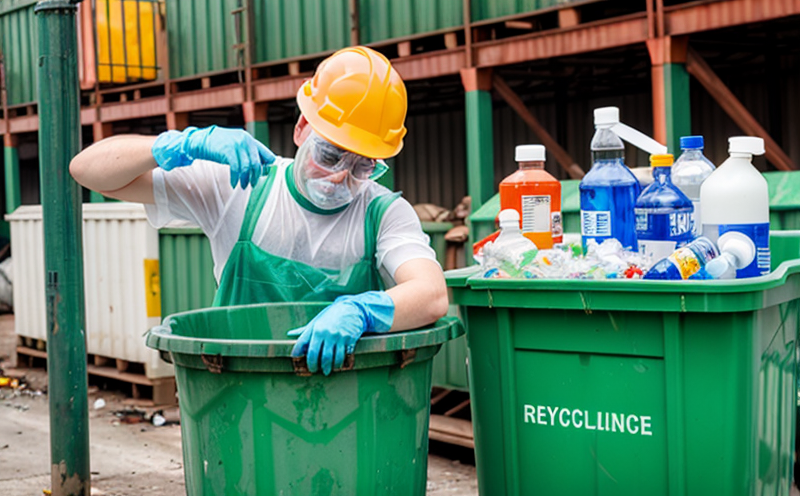BS EN 15935 Waste Analysis for Mercury Testing
The British Standard and European Norm (BS EN) 15935 is a critical document that sets out the methodology for determining the concentration of mercury in waste materials. This standard ensures consistent, accurate, and reliable measurement of mercury in various types of waste streams, which is essential for compliance with environmental regulations and safe disposal practices.
The test procedure outlined in BS EN 15935 involves multiple stages that include sample preparation, digestion, and the use of specialized analytical techniques to measure mercury. The process begins with the collection of representative samples from waste streams, ensuring a precise reflection of the material being analyzed. Proper sample preparation is crucial as it directly impacts the accuracy of the results.
After collecting the samples, they are digested using appropriate chemicals and methods, which break down complex materials into simpler forms that can be more easily analyzed for mercury content. This step ensures that all relevant compounds containing mercury are liberated from the sample matrix. Once the digestion process is complete, the solution is filtered to remove any insoluble residues.
The filtered solution is then subjected to atomic absorption spectrophotometry (AAS) or inductively coupled plasma optical emission spectrometry (ICPOES), which are highly sensitive analytical techniques capable of detecting even trace amounts of mercury. These methods provide precise and accurate measurements, ensuring compliance with stringent environmental standards.
The BS EN 15935 procedure also emphasizes the importance of quality control measures throughout the testing process. This includes the use of certified reference materials (CRMs) to calibrate instruments and validate results, as well as the implementation of standard operating procedures (SOPs) to ensure consistency in sample preparation and analysis.
By adhering to these rigorous protocols, laboratories can provide reliable data that are crucial for regulatory compliance. The accurate measurement of mercury in waste materials is essential for ensuring that hazardous substances do not enter the environment, thereby protecting public health and the ecosystem.
Benefits
- Achieve Regulatory Compliance: Ensures adherence to environmental regulations by providing accurate mercury concentration data for waste streams.
- Enhance Safety: Identifies hazardous materials containing mercury, enabling safe disposal and minimizing risks to human health and the environment.
- Sustainable Waste Management: Supports sustainable practices by facilitating informed decision-making regarding waste treatment and recycling processes.
- Improved Data Accuracy: Utilizing standardized methods ensures consistent and reliable results across different laboratories and testing facilities.
Quality and Reliability Assurance
The quality assurance process in BS EN 15935 is comprehensive, involving multiple layers of verification to ensure the accuracy and reliability of test results. This includes the use of certified reference materials (CRMs) for calibration and validation purposes. CRMs are essential as they provide a known standard against which test results can be compared, ensuring that measurements are within acceptable tolerances.
Additionally, laboratories must adhere to strict quality control protocols throughout the testing process. This includes regular instrument calibration, method validation, and participation in proficiency testing programs (PTPs). PTPs involve sending samples to multiple laboratories for independent analysis, allowing for cross-laboratory comparison and identifying any discrepancies.
The standard also emphasizes the importance of traceability of results, ensuring that every step from sample collection to final reporting can be accurately reproduced. This is achieved by maintaining detailed records of all testing procedures and conditions, which are subject to internal audits and external inspections.
By implementing these rigorous quality assurance measures, laboratories not only meet regulatory requirements but also build trust with clients and stakeholders. The consistent accuracy and reliability of test results enhance the credibility of the laboratory’s services, fostering long-term relationships and professional reputation.
Environmental and Sustainability Contributions
The implementation of BS EN 15935 plays a vital role in environmental protection by ensuring that hazardous substances like mercury are properly managed and disposed of. By accurately measuring the concentration of mercury in waste materials, this standard helps prevent the release of harmful pollutants into the environment. This contributes to reduced pollution levels, improved air quality, and healthier ecosystems.
Moreover, the accurate identification and quantification of mercury content allow for more efficient waste management strategies. For instance, hazardous waste can be segregated from non-hazardous waste, enabling targeted treatment methods that are both environmentally friendly and cost-effective. This segregation also facilitates recycling opportunities, where appropriate, reducing overall environmental impact.
The standard’s emphasis on traceability and accuracy supports sustainable practices by ensuring that all stakeholders have reliable data for decision-making. This promotes the development of circular economy models, where waste is seen as a resource rather than a burden. By reusing or repurposing materials containing mercury, industries can minimize raw material extraction and reduce energy consumption associated with manufacturing new products.
Overall, BS EN 15935 contributes significantly to environmental sustainability by promoting responsible waste management practices that protect public health and the environment while supporting sustainable development goals (SDGs).





